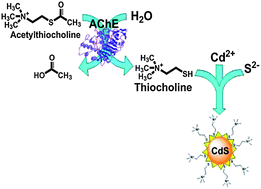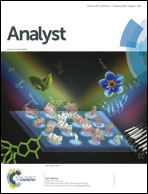Thiocholine mediated stabilization of in situ produced CdS quantum dots: application for the detection of acetylcholinesterase activity and inhibitors†
Abstract
The use of acetylcholinesterase (AChE) inhibitors as chemical warfare agents or pesticides represents a strong hazard against human health. The high toxicity of these compounds arises from their ability to inhibit acetylcholinesterase from degrading acetylcholine (ACh), which could affect the physiology of the nervous system with serious or fatal consequences. Here we report a simple and fluorimetric system for a highly sensitive detection of AChE activity and inhibitors. The principle of this approach is based on the hydrolysis of acetylthiocholine (ATCh) by AChE, which yields the thiol-bearing compound thiocholine (TCh) that at trace concentrations stabilized the in situ generated CdS quantum dots (QDs). The system shows a linear relationship between the fluorescence intensity and AChE activity from 1 to 10 mU mL−1 in buffer solution. The accuracy of the proposed system was further demonstrated through the determination of AChE activity in human serum (HS) by the standard addition method. Furthermore, this novel and highly sensitive sensing system allows the detection of 80 pM of the AChE inhibitor paraoxon and 100 nM of galanthamine. The reported methodology shows potential applications for the development of a simple and inexpensive assay for the routine quantification of AChE activity and inhibitors.


 Please wait while we load your content...
Please wait while we load your content...